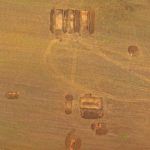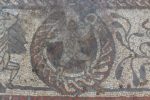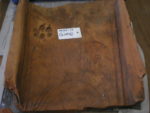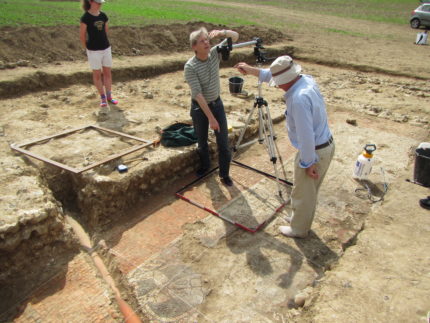 Archaeologists and community volunteers have unearthed an extraordinary Roman mosaic floor in the remains of an otherwise modest Roman villa in Boxford, West Berkshire. The mosaic dates to the late 4th century, about 380 A.D., when incursions from Saxons, Picts and Irish were on the rise and the usurper Western Roman Emperor Magnus Maximus (r. 383–87 A.D.) was withdrawing troops stationed in Britain to reinforce his army in his home base of Gaul. Other villas in Britain have been found with handsome new mosaics laid around this time, however, so it seems some of the rural villas at least were prosperous and secure enough to invest in new art. (Urban population, on the other hand, cratered and richly appointed town houses from this period are rare.)
Archaeologists and community volunteers have unearthed an extraordinary Roman mosaic floor in the remains of an otherwise modest Roman villa in Boxford, West Berkshire. The mosaic dates to the late 4th century, about 380 A.D., when incursions from Saxons, Picts and Irish were on the rise and the usurper Western Roman Emperor Magnus Maximus (r. 383–87 A.D.) was withdrawing troops stationed in Britain to reinforce his army in his home base of Gaul. Other villas in Britain have been found with handsome new mosaics laid around this time, however, so it seems some of the rural villas at least were prosperous and secure enough to invest in new art. (Urban population, on the other hand, cratered and richly appointed town houses from this period are rare.)
 The villa itself was not one of the huge luxury country estates. It had a farmhouse, a bath and a medium-sized villa of no special architectural interest with one big exception: a spectacular mosaic floor. The excavation team was only able to unearth less than half of it before the close of the dig, and the fraction that has been revealed is already breaking new ground in the art history of Roman Britain. The mythological themes depicted include imagery that hasn’t been found before in Britain. That iconographic variety has inspired one expert to call this the most important Roman mosaic unearthed in Britain in the last 50 years. The figures and flourishes aren’t as finely drawn as those in the fanciest homes and public buildings — the owner must not have had access to or been able to could afford the services of the greatest artists — but the subject matter makes the mosaic unique in the British art historical record.
The villa itself was not one of the huge luxury country estates. It had a farmhouse, a bath and a medium-sized villa of no special architectural interest with one big exception: a spectacular mosaic floor. The excavation team was only able to unearth less than half of it before the close of the dig, and the fraction that has been revealed is already breaking new ground in the art history of Roman Britain. The mythological themes depicted include imagery that hasn’t been found before in Britain. That iconographic variety has inspired one expert to call this the most important Roman mosaic unearthed in Britain in the last 50 years. The figures and flourishes aren’t as finely drawn as those in the fanciest homes and public buildings — the owner must not have had access to or been able to could afford the services of the greatest artists — but the subject matter makes the mosaic unique in the British art historical record.
 The central panel, which has not been fully uncovered yet, depicts scenes from the life of the her Bellerophon. In one he is borne aloft by the winged stallion Pegasus as he attacks the chimera. Another scene is believed to depict King Iobates offering Bellerophon his daughter Philonoe’s hand in marriage as a reward for his successful killing of the chimera. If the provisional identification can be confirmed when the rest of the mosaic is excavated, this will be the only known mosaic depiction of this particular scene from the Bellerophon mythos ever discovered from Roman Britain.
The central panel, which has not been fully uncovered yet, depicts scenes from the life of the her Bellerophon. In one he is borne aloft by the winged stallion Pegasus as he attacks the chimera. Another scene is believed to depict King Iobates offering Bellerophon his daughter Philonoe’s hand in marriage as a reward for his successful killing of the chimera. If the provisional identification can be confirmed when the rest of the mosaic is excavated, this will be the only known mosaic depiction of this particular scene from the Bellerophon mythos ever discovered from Roman Britain.
 Another rare element on this mosaic is an inscription. Experts haven’t deciphered it yet, but first impressions suggest it may be related to the scenes from the life and acts of Bellerophon depicted in the central panel. The thick bottom border of the mosaic contains more significant iconography. There’s a Cupid in a medallion in the middle, a telamon and an atlantid (bemuscled male versions of caryatids used as architectural features) in the corners, set in medallions of their own tilted diagonally. All three figures stretch outside the confines of their medallions, the corner figures performing their mythologically correct functions by holding up the borders of the central panel. This extension of the bodies outside the edges of their framing devices is extremely unusual in Roman mosaics.
Another rare element on this mosaic is an inscription. Experts haven’t deciphered it yet, but first impressions suggest it may be related to the scenes from the life and acts of Bellerophon depicted in the central panel. The thick bottom border of the mosaic contains more significant iconography. There’s a Cupid in a medallion in the middle, a telamon and an atlantid (bemuscled male versions of caryatids used as architectural features) in the corners, set in medallions of their own tilted diagonally. All three figures stretch outside the confines of their medallions, the corner figures performing their mythologically correct functions by holding up the borders of the central panel. This extension of the bodies outside the edges of their framing devices is extremely unusual in Roman mosaics.
Between the Cupid and the atlantid is an outline drawing of a man in a thick cloak wields a club against a centaur, likely a depiction of Hercules, clad in the skin of the Nemean Lion, battling Nessus. Technically Hercules killed Nessus with a poison arrow (a key plot point), but their battle was often depicted as hand-to-hand combat in artworks from antiquity well into the modern era. I’m thinking it could be Theseus vs. Eurytus. Mythological accounts describe that fight as hand-to-hand. The iconography could work too, at least from what I can see in the pictures. Hercules wasn’t the only hero with a club. Theseus had a particularly good one, the bronze club with which he’d killed its former wielder Periphetes, the cyclopean son of Vulcan. He was frequently shown holding the club in vase decorations and mosaics. I can’t see a lion head on the garment — unless those lines on his left pectoral muscle are meant to be a lion head? — and without that key evidence it could just be a cloak, another accessory common in portraits of Theseus and many other heroes.
 The site has been excavated in short summer seasons as part of the Boxford History Project since 2011, led by professional archaeologists from Cotswold Archaeology and staffed largely by volunteers. The last three seasons, funded by the Heritage Lottery Fund, have unearthed masses of tile, pottery fragments and the walls of multiple buildings, including the small villa. The team has reburied all of this year’s finds for their own safety and conservation. They will return next year and pick up where they left off excavating the mosaic.
The site has been excavated in short summer seasons as part of the Boxford History Project since 2011, led by professional archaeologists from Cotswold Archaeology and staffed largely by volunteers. The last three seasons, funded by the Heritage Lottery Fund, have unearthed masses of tile, pottery fragments and the walls of multiple buildings, including the small villa. The team has reburied all of this year’s finds for their own safety and conservation. They will return next year and pick up where they left off excavating the mosaic.
